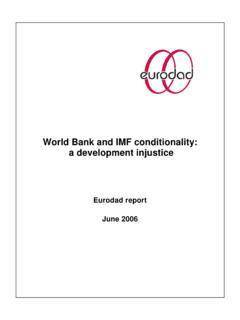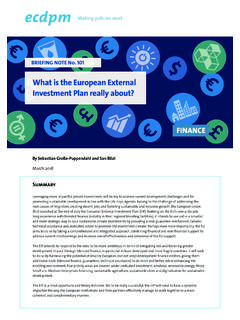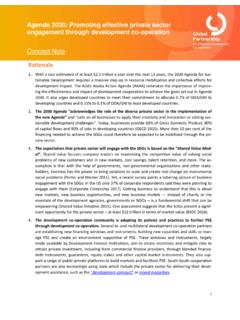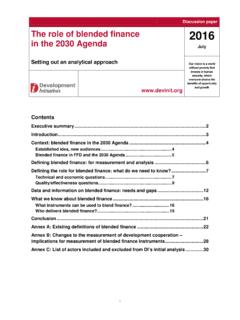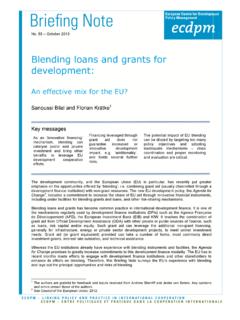Transcription of Blended Finance: What it is, how it works and how …
1 RESEARCH REPORT FEBRUARY 2017 Port de Pointe-Noire in the Republic of the Congo (Brazzaville), supported by a 328m Blended finance package. Photo: Congo Terminal Pointe-Noire. Blended finance What it is, how it works and how it is used JAVIER PEREIRA Independent consultant In recent years, blending has become a common development finance term. The practice combines official development assistance with other private or public resources, in order to leverage additional funds from other actors. There is some confusion about its meaning, how it works , and how it fosters development, as well as a significant lack of project data.
2 Blending can be problematic: it does not necessarily support pro-poor activities, often focuses on middle-income countries, and may give preferential treatment to donors own private-sector firms. Projects may not align with country plans, and commonly fail to incorporate transparency, accountability, and stakeholder participation. This report aims to clarify what blending is, how it works and how it is used, to foster greater understanding of this increasingly prominent development finance mechanism. 2 Blended finance CONTENTS List of acronyms 3 Executive summary 5 Introduction 6 1 Blending as a global phenomenon 8 2 Analysis of the sample blending facilities 22 3 Concluding remarks 43 Annex I: Methodology 45 Annex II.
3 Ex ante additionality assessment in EC blending projects 46 Notes 47 Acknowledgements 51 Blended finance 3 LIST OF ACRONYMS AECID Spanish Development Cooperation Agency ADF French Development Agency AfDB African Development Bank AfIF Africa Investment Facility AIF Asia Investment Facility CDB Caribbean Development Bank CEB Council of Europe Development Bank CIF Caribbean Investment Facility CRS Creditor Reporting Service DAC Development Assistance Committee DEG German Investment Corporation DFI Development finance institution DG DEVCO Directorate-General for International Cooperation and Development DGGF Dutch Good Growth Fund EBRD European Bank for Reconstruction and Development EC European Commission ECA European Court of Auditors EU European Union EIB European Investment Bank GFF Global Financing Facility in Support of Every Mother.
4 Every Child HRITF Health Results Innovation Trust Fund IBRD International Bank for Reconstruction and Development IDA International Development Association IDB Inter-American Development Bank IFCA Investment Facility for Central Asia IFP Investment Facility for the Pacific ITF EU-Africa Infrastructure Trust Fund KfW Reconstruction Credit Institute (Germany) 4 Blended finance LAIF Latin America Investment Facility M&E Monitoring and evaluation NIF Neighbourhood Investment Facility NORAD Norwegian Agency for Development Cooperation ODA Official development assistance OECD Organisation for Economic Co-operation and Development PIDG Private Infrastructure Development Group PPP Public-private partnership PwC PricewaterhouseCoopers RMNCAH Reproductive, maternal, newborn, child, and adolescent health SCDB Seed Capital & Business Development Programme SIMEST Societ italiana per le imprese all'estero (Italian DFI)
5 SMEs Small- and medium-size enterprises TA Technical assistance TOSSD Total Official Support for Sustainable Development WEF World Economic Forum Blended finance 5 EXECUTIVE SUMMARY In the past few years, blending has become a common term in development finance . However, there is some confusion about what it means and, by extension, how it works and contributes to the achievement of certain development objectives. This report intends to weigh in on this debate by exploring blending through three different questions: What is blending? How does it work? And how is it being used? Blending can be broadly defined as the combination of public concessional official development assistance (ODA) with private or public resources, generally with the aim of mobilizing or leveraging development finance from other actors.
6 Beyond the mechanics of blending, there are several other elements that influence its development impact. Accounting for the use of ODA and the resources it mobilizes is a key part of blending projects implementation and the cornerstone of any further analysis. Such factors as the choice of project partners and beneficiaries and the quality of decision-making structures, project design, and monitoring and evaluation mechanisms all have a crucial bearing on the development outcomes. The report builds on evidence from three blending facilities and pays particular attention to the use of ODA for blending purposes. The result of this exercise is a list of several specific quantitative and qualitative risks associated with the practice of blending that could undermine its impact or that of development assistance flows in general.
7 Key risks include: ODA and development finance inflation. The lack of a common methodology to account for ODA for blending and mobilized finance can lead to double-counting and makes it possible to report it as ODA money, which is not spent in a concessional way. ODA diversion from other aid modalities. New accounting methodologies could provide intended or unintended incentives for using blending ( because in addition to ODA, donors can report significant amounts of mobilized finance ). Moreover, it is also possible that blending projects are easier to align with donors political and economic priorities, compared with other forms of ODA ( the support of national private sector companies).
8 ODA concentration on certain sectors and/or countries. For example, strong financial sustainability requirements in blending facilities, or the managers and/or the absence of incentives to focus on pro-poor projects, could lead donors to focus on countries and sectors with a lower risk profile, such as middle-income countries. Lack of demonstrable development effects. Weaknesses in monitoring and evaluation systems, or inadequate definitions of additionality, may allow projects to proceed in the absence of demonstrable impacts or on the basis of financial performance. Lack of coordination with bilateral aid agencies and other donors.
9 The use of indirect channels of support and, often, the transfer of responsibility to external managers or project leaders, can make it difficult to coordinate donors and their alignment with country plans. Poor project ownership and accountability. Transparency is a challenge in many blending projects. In addition, several of the actors involved lack independent complaint mechanisms. These issues make it difficult for affected stakeholders to channel their concerns and hold donors accountable. The participation of public and private stakeholders in project decisions is also a major challenge in blending projects, especially those involving the private sector.
10 6 Blended finance INTRODUCTION In the last few years, blending has become a common term in development finance ; it often appears associated with other financial terms, such as leveraging . However, there is some confusion about what it means, and, by extension, how it works and contributes to the achievement of certain development objectives. There is also a significant lack of data and evidence about blending projects; something that can be partly explained by the lack of a common language and understanding of This report intends to contribute to the building of a common and specific language of blending. The objective of this report is to identify areas that are key to maximizing the development impact of blending projects and describe the associated quantitative and qualitative risks.

